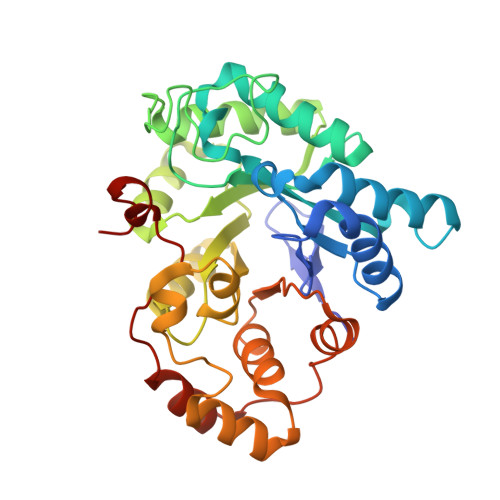Studies of the enzymic mechanism of Candida tenuis xylose reductase (AKR 2B5): X-ray structure and catalytic reaction profile for the H113A mutant
Kratzer, R., Kavanagh, K.L., Wilson, D.K., Nidetzky, B.(2004) Biochemistry 43: 4944-4954
- PubMed: 15109252
- DOI: https://doi.org/10.1021/bi035833r
- Primary Citation of Related Structures:
1R38 - PubMed Abstract:
Xylose reductase from the yeast Candida tenuis (CtXR) is a family 2 member of the aldo-keto reductase (AKR) superfamily of proteins and enzymes. Active site His-113 is conserved among AKRs, but a unified mechanism of how it affects catalytic activity is outstanding. We have replaced His-113 by alanine using site-directed mutagenesis, determined a 2.2 A structure of H113A mutant bound to NADP(+), and compared catalytic reaction profiles of NADH-dependent reduction of different aldehydes catalyzed by the wild type and the mutant. Deuterium kinetic isotope effects (KIEs) on k(cat) and k(cat)/K(m xylose) show that, relative to the wild type, the hydride transfer rate constant (k(7) approximately 0.16 s(-1)) has decreased about 1000-fold in H113A whereas xylose binding was not strongly affected. No solvent isotope effect was seen on k(cat) and k(cat)/K(m xylose) for H113A, suggesting that proton transfer has not become rate-limiting as a result of the mutation. The pH profiles of log(k(cat)/K(m xylose)) for the wild type and H113A decreased above apparent pK(a) values of 8.85 and 7.63, respectively. The DeltapK(a) of -1.2 pH units likely reflects a proximally disruptive character of the mutation, affecting the position of Asp-50. A steady-state kinetic analysis for H113A-catalyzed reduction of a homologous series of meta-substituted benzaldehyde derivatives was carried out, and quantitative structure-reactivity correlations were used to factor the observed kinetic substituent effect on k(cat) and k(cat)/K(m aldehyde) into an electronic effect and bonding effects (which are lacking in the wild type). Using the Hammett sigma scale, electronic parameter coefficients (rho) of +0.64 (k(cat)) and +0.78 (k(cat)/K(m aldehyde)) were calculated and clearly differ from rho(k(cat)/K(aldehyde)) and rho(k(cat)) values of +1.67 and approximately 0.0, respectively, for the wild-type enzyme. Hydride transfer rate constants of H113A, calculated from kinetic parameters and KIE data, display a substituent dependence not seen in the corresponding wild-type enzyme rate constants. An enzymic mechanism is proposed in which His-113, through a hydrogen bond from Nepsilon2 to aldehyde O1, assists in catalysis by optimizing the C=O bond charge separation and orbital alignment in the ternary complex.
Organizational Affiliation:
Institute of Biotechnology, Graz University of Technology, Petersgasse 12/I, A-8010 Graz, Austria.















